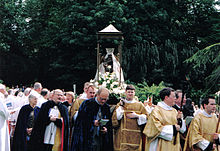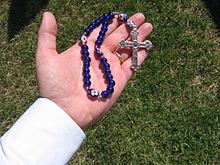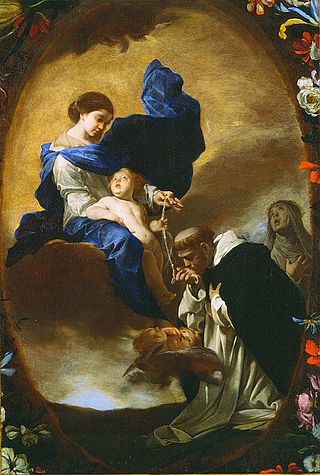
The Rosary, also known as the Dominican Rosary, refers to a set of prayers used primarily in the Catholic Church, and to the physical string of knots or beads used to count the component prayers. When referring to the prayer, the word is usually capitalized ; when referring to the prayer beads as an object, it is written with a lower-case initial letter.

Worship is showing regard with great respect, honor, or devotion. This may be encountered in religious settings. In such instances it may represent divine worship; reverence for a divine being or supernatural power. This activity may have other focuses, such as hero worship. Worship may involve one or more of activities such as veneration, adoration, praise, supplication, devotion, prostration, or submission. An act of worship can be performed as simple prayer or through elaborate ceremony, individually, in an informal or formal group, or by a designated leader. The focus of worship is ultimately honoring the subject in some manner.

Intercession of the Saints is a Christian doctrine that maintains that saints can intercede for others. To intercede is to go or come between two parties, to plead before one of them on behalf of the other. It is held by the Catholic, Eastern Orthodox, Assyrian Church of the East, and Oriental Orthodox churches, and some Lutherans and Anglicans. The practice of praying to saints for their intercession can be found in Christian writings from the 3rd century onwards.

A sacramental is a sacred sign, a ritual act or a ceremony, which, in a certain imitation of the sacraments, has a spiritual effect and is obtained through the intercession of the Church. Sacramentals surround the sacraments like a wreath and extend them into the everyday life of Christians. Sacramentals are recognised by the Roman Catholic Church, the Eastern Orthodox Church, the Oriental Orthodox Churches, the Church of the East, the Lutheran churches, the Old Catholic Church, the Anglican churches, Independent Catholic churches, and Methodist churches.

Marian hymns are Christian songs focused on Mary, mother of Jesus. They are used in both devotional and liturgical services, particularly by the Roman Catholic, Eastern Orthodox, Oriental Orthodox, Anglican, and Lutheran churches. They are often used in the month of May devotions. Some have also been adopted as Christmas hymns. Marian hymns are not popular among some Protestants, as they see Marian veneration as idolatry. However, the practice is very common among Christians of Catholic traditions, and a key component of the Eastern Orthodox liturgy. There are many more hymns to Mary within the Eastern Orthodox yearly cycle of liturgy than in Roman Catholic liturgy.

The Chaplet of the Divine Mercy, also called the Divine Mercy Chaplet, is a Catholic devotion to the Divine Mercy, based on the Christological apparitions of Jesus reported by Faustina Kowalska (1905–1938), known as "the Apostle of Mercy". She was a Polish religious sister of the Congregation of the Sisters of Our Lady of Mercy and canonized as a Catholic saint in 2000.

A novena is an ancient tradition of devotional praying in Christianity, consisting of private or public prayers repeated for nine successive days or weeks. The nine days between the Feast of the Ascension and Pentecost, when the disciples gathered in the upper room and devoted themselves to prayer, is often considered to be the first novena.

Marian devotions are external pious practices directed to the person of Mary, mother of God, by members of certain Christian traditions. They are performed in Catholicism, High Church Lutheranism, Anglo-Catholicism, Eastern Orthodoxy and Oriental Orthodoxy, but generally rejected in other Christian denominations.
A prayer book is a book containing prayers and perhaps devotional readings, for private or communal use, or in some cases, outlining the liturgy of religious services. Books containing mainly orders of religious services, or readings for them are termed "service books" or "liturgical books", and are thus not prayer-books in the strictest sense, but the term is often used very loosely. A religion's scriptures might also be considered prayer books as well.

Catholic devotions are particular customs, rituals, and practices of worship of God or honour of the saints which are in addition to the liturgy of the Catholic Church. The United States Conference of Catholic Bishops describes devotions as "expressions of love and fidelity that arise from the intersection of one's own faith, culture and the Gospel of Jesus Christ". Devotions are not considered part of liturgical worship, even if they are performed in a church or led by a priest, but rather they are paraliturgical. The Congregation for Divine Worship at the Vatican publishes a Directory on Popular Piety and the Liturgy.
Anglican Marian theology is the summation of the doctrines and beliefs of Anglicanism concerning Mary, mother of Jesus. As Anglicans believe that Jesus was both human and God the Son, the second Person of the Trinity, within the Anglican Communion and Continuing Anglican movement, Mary is accorded honour as the theotokos, a Koiné Greek term that means "God-bearer" or "one who gives birth to God".

Popular piety in Christianity is an expression of faith which avails of certain cultural elements proper to a specific environment which is capable of interpreting and questioning in a lively and effective manner the sensibilities of those who live in that same environment. Its forms in the Roman Catholic Church are explained in the Directory on Popular piety and the liturgy issued by the Congregation for Divine Worship and the Discipline of the Sacraments of the Catholic Church. In the Lutheran Churches, popular piety is expressed through the reception of the sacraments, the displaying of sacred art, the signing of hymnody, prayer, Bible study and devotions.
Saint Augustine's Prayer Book is an Anglo-Catholic devotional book published for members of the various Anglican churches in the United States and Canada by the Order of the Holy Cross, an Anglican monastic community.

Prayer in the Catholic Church is "the raising of one's mind and heart to God or the requesting of good things from God." It is an act of the moral virtue of religion, which Catholic theologians identify as a part of the cardinal virtue of justice.
Quiet time, also stated as heart-to-heart time, or one-on-one time with the creator, is a regular individual session of Christian spiritual activities, such as prayer, private meditation, contemplation, worship of God or study of the Bible. The term "quiet time" or "sacred time" is used by 20th-century Protestants, mostly evangelical Christians. It is also called "personal Bible study" or "personal devotions". Rick Warren points out that it has also been called "morning watch" and "appointment with God".

Rosary-based prayers are Christian prayers said on a set of rosary beads, among other cords. These prayers recite specific word sequences on the beads that make up the different sections. They may be directed to Jesus Christ, the Virgin Mary or God the Father.
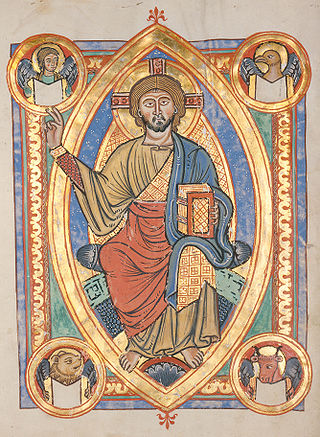
The Roman Catholic tradition includes a number of devotions to Jesus Christ. Like all Catholic devotions, these prayer forms are not part of the official public liturgy of the Church but are based on the popular spiritual practices of Roman Catholics. Many are officially approved by the Holy See as suitable for spiritual growth but not necessary for salvation.

Christian prayer is an important activity in Christianity, and there are several different forms used for this practice.

A home altar or family altar is a shrine kept in the home of a Western Christian family used for Christian prayer and family worship. Home altars often contain a cross or crucifix, a copy of the Bible, a breviary and/or other prayer book, a daily devotional, a headcovering, icons of Jesus Christ and prayer beads, among other religious articles specific to the individual's Christian denomination, for example, the images of the saints for Catholics, the Small Catechism for Lutherans, and the Anglican prayer beads for Anglicans.
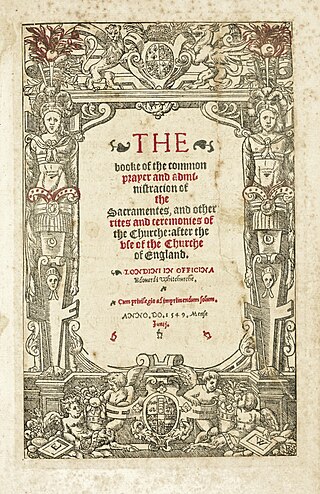
The 1549 Book of Common Prayer (BCP) is the original version of the Book of Common Prayer, variations of which are still in use as the official liturgical book of the Church of England and other Anglican churches. Written during the English Reformation, the prayer book was largely the work of Thomas Cranmer, who borrowed from a large number of other sources. Evidence of Cranmer's Protestant theology can be seen throughout the book; however, the services maintain the traditional forms and sacramental language inherited from medieval Catholic liturgies. Criticised by Protestants for being too traditional, it was replaced by the significantly revised 1552 Book of Common Prayer.


